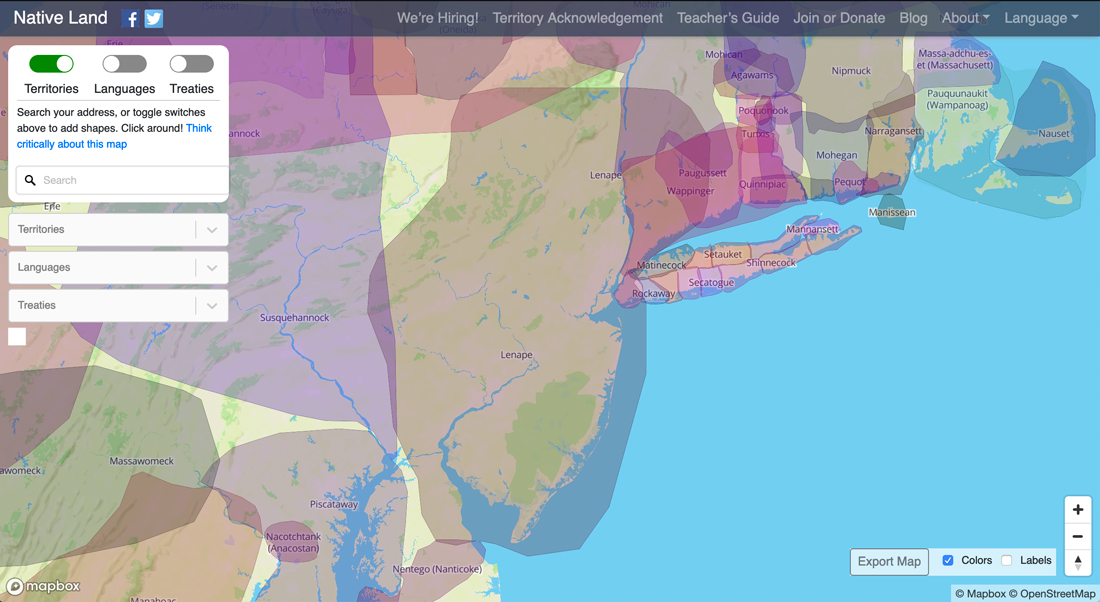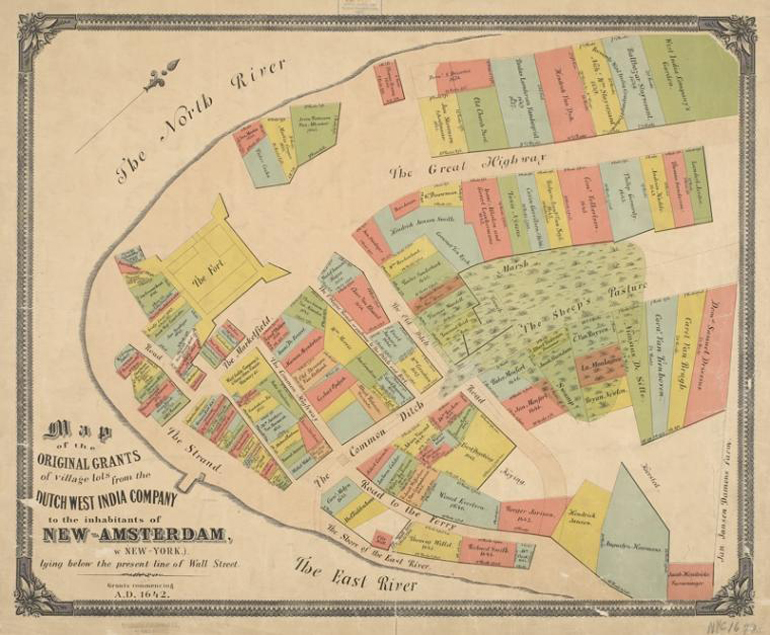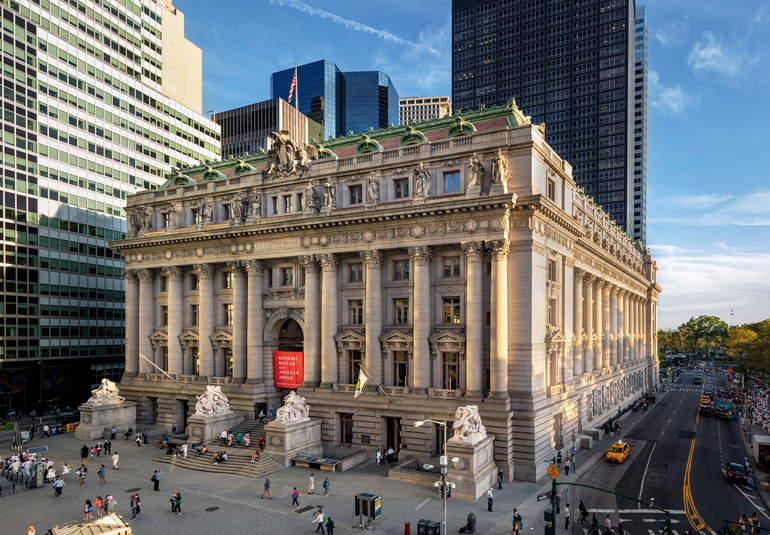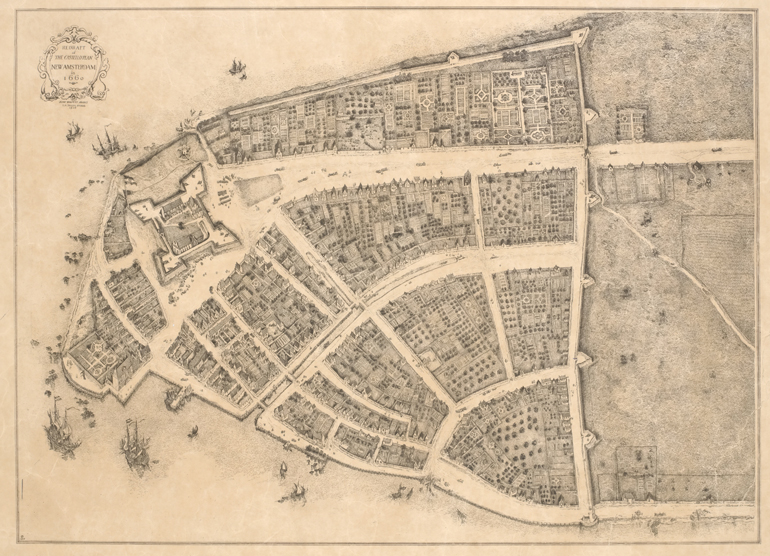
We are celebrating 15 years — and counting — of stories that are deeply researched and deeply felt, that build a historical record of what the city has been.
We are celebrating 15 years — and counting — of stories that are deeply researched and deeply felt, that build a historical record of what the city has been.
At the northeast corner of Union Square, a new turtle shell rises over the former Tammany Hall. The steel and glass dome alludes to the Indigenous leader from whom the building and the society it once housed took their name; the animal represents Chief Tamanend’s nation, the Lenape. The turtle is also a contemporary marker of Turtle Island: in the Lenape’s origin story, North America was created when a great turtle rose from the ocean.
Before this landmarked building was erected at the corner of 17th Street and Park Avenue —before the city’s grid plan had even established these coordinates on paper — the site was a dense woodland. The island of Manahahtaan was part of Lenapehoking. Encompassing a unity of land, people, living and nonliving things within its territory, Lenapehoking extended across what are today New York City and New Jersey, to portions of New York State, Pennsylvania, Delaware, and Connecticut. Centuries of occupation by European settlers, displacement, forced migration, and genocide of the original peoples, and intense development conspired to erase any sign of the Lenape’s long presence on the land. Today, New York City vaunts its diversity, with over 200 languages spoken, and a large population of American Indians from a number of tribal nations, but the relationship of the city to its original peoples is not part of the picture.
Yet Lenapehoking is still the homeland of the Lenape diaspora, which includes members of three federally recognized nations in Oklahoma and Wisconsin, and two in Ontario, Canada. The Lenape Center was established in 2008 with the mission of continuing Lenapehoking. The organization’s work has taken various forms, from staging an opera on the purchase of Manhattan, to consulting with BKSK Architects on Tammany Hall’s new turtle dome, and planting indigenous corn in the city’s community gardens. They also partner with other organizations seeking to promote the living culture of the Lenape. Land acknowledgements — in the form of opening statements at events, or plaques at the entrances to buildings — are becoming more common, as cultural institutions work to recognize the traditional indigenous people of the land where they are sited. Attempts to grapple with legacies of violence, displacement, and stolen lands, from debates on monuments to the Settler Colonial City Project’s recent project in Chicago, are complicating widely held understandings of the city’s history. But beyond recognizing the past, Lenape culture is pointed toward future generations. We spoke with Joe Baker and Hadrien Coumans, co-founders and co-directors (with Brent Michael Davids and Curtis Zunigha) of the Lenape Center, about their efforts to bring the original peoples and their culture back home in the 21st century.
What is at the origins of the Lenape Center, and what is the Lenape Center’s mission?
About ten years ago, I was standing on the Upper East Side with Joe. There was this very ominous feeling that the Lenape people were on the brink of complete erasure. Joe made a comment: “If we don’t begin to do something, we will completely be erased from memory.” He said, “No one’s heard of us. No one even talks about us. We no longer exist in the consciousness.”
A few weeks later, we found ourselves on the beach at night in Southampton. We looked down and we saw all these very bright miniature blue stars that were following our footsteps. As far as the eye could see, the whole beach was covered in blue stars. It was a clear night, and we looked up at the sky and saw stars and Joe said, “This is a sign from the ancestors, they want us to do this.” Scientifically, it was some kind of bioluminescent organism, but it was one of those moments of a deep knowing that the work needed to begin. We needed to create a center that would continue our presence, but also be a welcoming home for the diaspora.
Can you talk a little bit about the Lenape homeland itself — Lenapehoking and the diaspora?
It’s a large geographic area, and throughout that area, there are still many Lenape place names: Hackensack. Poughkeepsie. Manhattan is Manahahtaan, in the Munsee dialect of the Lenape, the place where wood is used to make the bows. The origin stories say that people came out from the top of the turtle shell of Turtle Island. There are a lot of theories of migrations and people coming from Eurasia, but it’s important to begin with what the oral stories say: that the people came from here.
We identify a diaspora because there are people throughout North America who are Lenape. There are five sovereign nations with full federal recognition, in Oklahoma, Wisconsin, and Ontario. These are nations who have had a continuous, unbroken history of being Lenape community.
I grew up in a small town in Oklahoma, which happened to be the center of the relocation of the main body of the Delaware Tribe of Indians. I’m a member of the Whiteturkey family. I had the honor of growing up among native Lenape speakers. I thought it was magical to be at the dances, to participate in the culture, to travel to powwows when I was a kid.
What I remember most about traditional native people is the ability to exercise a certain reserve, but a very descriptive and visual use of language. When the language is spoken, it has the softness of, perhaps, leaves in a tree. There’s a poetry to it that seems that it came specifically from a place, and I would say that place, of course, is here.
I had the privilege of spending time with Nora Thompson Dean, tribal elder, whom we always credit for the inspiration for our work with the Lenape Center. She had a very quiet way of telling me sensational things about her return visits to the homeland. She would describe the leaves, the sounds, the quality of the air, which in a very quiet, beautiful way, created this painting of a place. That sparked in me, even as a child, to wonder about this place that we came from, and to have a better understanding of what happened.
Our work is only the most recent effort coming from the Lenape community to continue in the homeland. Nora Thompson Dean was intent on expressing that she could see and feel her ancestors, and that it was her responsibility to return home to Lenapehoking. Archaeologists and historians had been working on the Lenape story, but had not filled in the pieces with the living members of the Lenape community. That missing part is an enormous part of the reality of Lenapehoking. Which is that the genocide, the erasure, is not something that was a one-act. It’s been an ongoing process, since the 1600s. And we see that it’s a generational responsibility to fill in what the erasure has swept.
I could see evidence where we lived that things had been really difficult. Aunts and uncles would come to play cards and we kids would listen to these conversations. I knew that something horrific had happened. It was much later in my life that I came to understand what had happened. And in many ways that has been the energy behind my movement as an adult to seek justice and to make sure that these things never happen again.
What should everyone know about the Lenape genocide and the development of Manhattan and New York City as we know them today?
There are some very significant facts that one should be aware of. One is that the Dutch West India Company was a corporate entity which was out for profit. It was not a story of settlers who were being religiously persecuted looking for a better way of life. It was modeled on the Dutch East India Company that had been colonizing Asia and Africa for a long time. The Dutch West India Company applied very sophisticated and damaging means of colonization, and that was a huge factor in the beginning of genocide. It wasn’t one warlike invasion, it was this amplifying means of conquest, of taking land and resources.
It’s important to point out that 95 percent of the woodlands in the Northeast were cut down. Combined with the massacres, the land theft, invasive crops, the decimation of crops, diseases that wiped out huge numbers of the people, it was an incredibly destructive time. The Lenape people lost the majority of their population, lost the majority of their homes, of everything that the people knew to be their environment. It was a holistic destructive mechanism.
I don’t know of any people on earth who actually want to migrate, to walk thousands of miles. People do it because they have no other choice. We talk about refugees today, internally displaced peoples, as a result of war. This is the same thing. This was all-out destruction, which means that if people want to survive, they have to go. By 1868, the largest group of Lenape numbered less than 900 individuals upon arriving in Indian Territory, Oklahoma.
That’s why there should be, at this point, more of an outreach effort by the State of New York, the City of New York, and the State of New Jersey, to begin to bring some clarity, some recognition, and some healing to the story.
What kinds of things could the city or state be doing?
The city has been chasing monuments. Those old clichés: Let’s name a street after them, let’s have a statue commemorating something. It’s so old!
In the same way that the city has provided space and welcomed the embassies of foreign countries, we should have the same respect as foreign countries. We are a sovereign nation: the Delaware Tribe of Indians, the Delaware Nation, and the Stockbridge-Munsee Community.
For a city that prides itself on being inclusive and welcoming of everyone, this is ironically the one peoples that have not been welcomed home in a formal way. The City and the State of New York should establish government-to-government relations with the federally recognized tribes and identify ways that the city could be a support for tribal members by facilitating access to resources, whether that be education, or employment, or internship, or even visitations. For allowing for participation in civic society.
Let the 15,000 or so members of the federally recognized tribes know that they are welcome, that they are an essential part of life in New York. That despite the time and space, now there are no more excuses. Even returning some land could be an enormous benefit to these nations. It could guarantee a means of support that they’ve never had.
Let’s talk about the land in New York City, and the physical erasure of the Lenape presence. Where is, and isn’t there, access to that presence?
The Smithsonian National Museum of the American Indian, which sits on the footprint of the Dutch West India fort of New Amsterdam, has never had a Lenape exhibit.
But they are opening one soon?
There’s an exhibit that they have been working on, called “Native New Yorkers,” which is very problematic. New York is, whether we like it or not, a colonial construct. It doesn’t represent the original territories. This is an incredibly rich and complex and incredibly unknown history and culture. Why dilute it? That type of erasure is some of the most problematic, because it gives a false sense that there is an acknowledgment that is being satisfied. And for a general public who doesn’t know any better, they feel like the museum is doing their due diligence.
Many institutions in New York City and nationally are scrambling to catch up, to make land acknowledgements. This conversation is part of that, too.
At the Metropolitan Museum of Art, there is a land acknowledgement, and we were able to provide a welcome, on the walls of a long-overdue Native exhibit. But it’s 2020. The erasure isn’t only in terms of the city’s history and the architectural artifacts, it’s also in the ongoing and new efforts that have failed to really acknowledge this history and acknowledge the people.
The Lenape Center talks about “living land acknowledgement.” What’s the distinction?
Land acknowledgment has been ongoing and much more prominent in Australia and New Zealand, even in Canada. We have observed, as an organization, that sometimes those acknowledgments are very hollow. We wanted to introduce the idea that the acknowledgment has to begin first with action, followed by words, so that those words could actually recount and express the actions that have taken place. Without that living action component, land acknowledgment could actually be detrimental to indigenous causes, because it gives a pass and an absolution of responsibility. It’s a bit like institutions buying themselves a way of satisfying some kind of guilt.
What kind of actions meaningfully precede the words?
Prior to the posting of their land acknowledgment on a plaque on the wall, the Brooklyn Museum began identifying what resources they could utilize to inform action. That came in the way of a symposium on land acknowledgment itself, which enabled us to bring in representatives from the diaspora and build on institutional, intragovernmental relations. As a large institution, they were able to demonstrate that can be done rather efficiently and quickly: within a few weeks. And that was the beginning of relationships that are ongoing.
What kind of work is the Lenape Center undertaking in New York City right now, and with whom?
Some years ago, we advised on the plaque at Columbia University that was put up by the Native American student group. We knew back then that they didn’t want to have just a plaque. Students today don’t want just words, they want actions.
Columbia is offering scholarships to residents of Harlem, which I think is wonderful, but I’m also thinking: What about the people who came before Harlem? I would hope that more universities would begin to think about the original people.
Those types of actions would change people’s lives. We’re giving a course at the School of Social Work this spring. One of the wonderful results of our presence there is that in being given that platform, we’ve been able to legitimize non-European students’ cultures, as opposed to only clinical, Western ideology.
We’re beginning talks for a Lenape exhibit at the Brooklyn Museum. Any museum that will be the first to properly create such an exhibit will benefit enormously. We continuously have visitors coming from abroad asking where the Lenape material is. Where can they go? Because they’ve gone to museums, they haven’t seen anything. We are dealing with a sophisticated, global group of visitors who, as tourists, are already coming informed. There are 58 million people coming from abroad to New York City each year. They’re coming with their already-established mindsets of land acknowledgment, knowing that they want to pay respect to whose land they’re visiting.
Are there better examples that New York could be learning from?
When one lands in Vancouver, the airport is clearly demonstrating a recognition of indigenous peoples and land. It’s through the art and what’s expressed. That’s part of a societal and cultural fabric that’s all-encompassing. One can’t remove that indigenous consciousness from everyday life. As a country, the US gets a really poor grade in terms of recognition and acknowledgment. Let’s just look a bit more south. Seattle is within that same cultural center, and yet, in comparison, has done almost nothing in terms of creating that civic understanding of place and people.
What could that civic understanding look like here? You recently worked with the architects of the renovation of Tammany Hall on a new dome for the building.
Tammany Hall is an example of how an architectural firm has, from the beginning, done everything in the best way to bring out a sense of recognition and place of honoring the original people. I credit Todd Poisson for having led the most thoughtful effort to include the Lenape every step of the way. We’re very happy with the glass turtle dome roof, and it’s rare to have an example in the city of thorough consultation that resulted in something that is really a new landmark.
Tammany Hall, as a political organization, did not care for the well-being of the Lenape, and was using a romanticized notion of a chief. It’s exciting to have an architectural firm realize the misappropriation of this name historically, but also see that there is an opportunity to bring in authentic, legitimate voice and representation into the story. That’s more exciting than a monument — that’s actually creating change.
You have worked with the same architects to explore the idea of a physical Lenape Center in Northern Manhattan. What do you hope to see in another ten years?
My vision for our work would be that we would be able to provide access to the city and all of its cultural amenities, all of its educational opportunities, for Lenape people. That people could come and go from here, knowing that this is their homeland, and be inspired by contemporary life that’s here today, and the creativity of the city. It’s always been our goal to return to Lenapehoking.
Inwood Hill Park is still original Lenapehoking nature. There is a timeless quality. It feels good for anyone on Earth to go through nature and go on walks and go outdoors, but this is a place that is ancient, that has been a significant part of the Lenape presence and identity. There are sacred caves and trees. That’s a place that elders have always talked about as such an important site.
We’ve certainly been using that line — “Where are you based? Manhattan” — for some time now.
It’s been many thousands of years, and it will be many thousands more.
The Lenape Center isn’t concerned just with the presence of the past, but with calling attention to the continuing effects of environmentally and socially destructive practices.
The Lenape culture is forward-thinking, and it is about survivance — what the people have done, collectively, as a means of survival — not about replicating something of the past. That forward-thinking mindset is all the more needed now in the city.
I think that in the absence of Lenape leadership since forced migration out of Lenapehoking, environmentally, New York City, New York State, the United States have done a terrible job. The wall at Wall Street meant that in a very simple way, that was a break in the holistic ecosystem of the island. It meant that the Lenape would not be invited to take part in creating balance with Mother Earth going forward. One can easily point out that the only source of fresh water, Collect Pond, was polluted very quickly by the colonists.
Now, as people start to really grapple with the climate crisis, they are looking to indigenous knowledge and practices, including building.
Lenape architecture was around for over 10,000 years for a reason. Why the wigwams, why the long houses? It is strange to see what we, as a country, call colonial architecture in these white-painted, wood-siding homes throughout the Northeast as if this was some kind of automatic indigenous architecture. It doesn’t fit the environment. In terms of heating and efficiency, we haven’t even begun to look at the basic premise of what indigenous architecture really is. What we have now is a very disorganized, individualistic expression of towers going up which don’t communicate with one another, which don’t communicate with the land, which don’t have any connection to place. And somehow, we feel like that is appropriate.
In our own lifetimes, the damage has been so profound that young people don’t want to have kids. The Paris climate talks and every single occasion of world leaders gathering has not yielded action, it has yielded more talk. It’s time that the respective government and corporate heads give up some of their need to hold the steering wheel and realize that they must allow for indigenous peoples to lead as it pertains to our future. I mean that for the Lenape, but also globally.
There’s a window of opportunity for this city to create an example for the world. And that door is beginning to close. We have a world in a phase which is much more (despite a global economy) isolationist. There’s fascism that’s rising, unchecked individual greed and selfishness are seen as positive attributes and give rise to delusions of power. Now’s the time to actually show that this is not the direction that the city wants to take.
This is a history of genocide that has never been acknowledged, and the city should say, “We’re going to begin to acknowledge this now, and we’re going to develop relations, and do it in such a way that the world should follow.” We have indigenous peoples in the Amazon being massacred for their land, just as the Lenape were here. It’s not enough to just tell the government in Brazil “Stop doing that,” but actually show through example.
The views expressed here are those of the authors only and do not reflect the position of The Architectural League of New York.







Comments